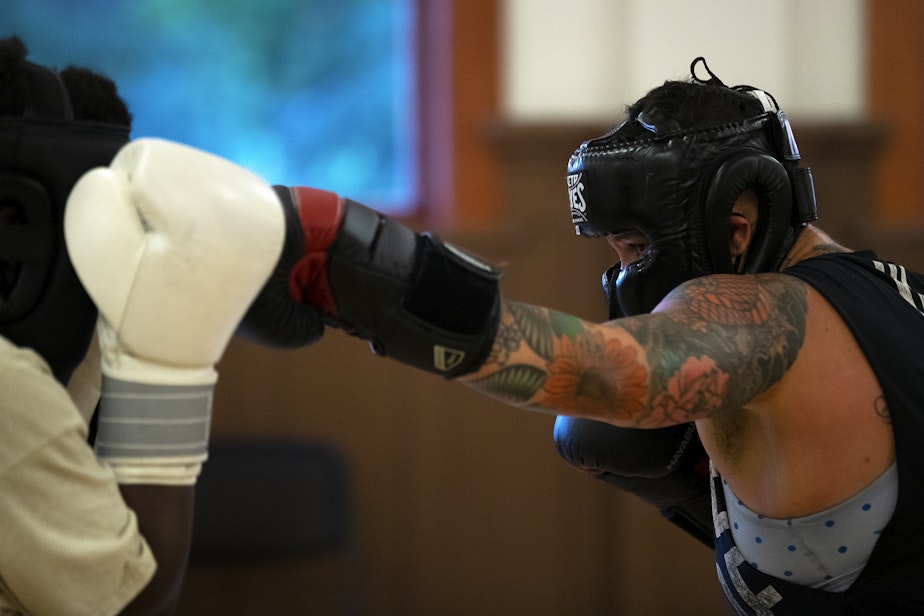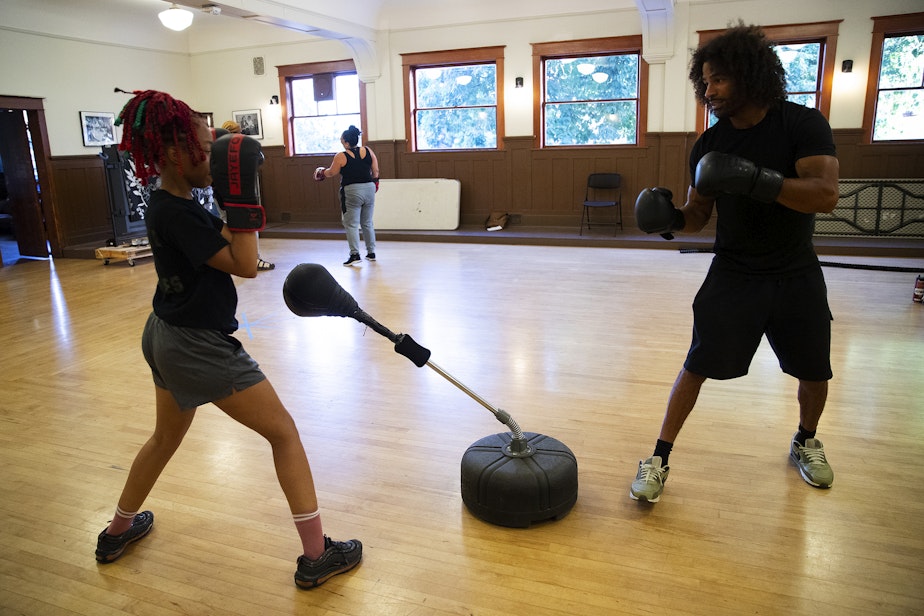For Seattle youth, boxing clubs offer lessons in overcoming conflict
In the main room of the Central District’s Washington Hall, rows of chairs have been cleared to transform the space into a makeshift boxing gym. The room now contains two freestanding punching bags, seven people, and a noisy industrial fan to keep the air circulating — it can get hot and sticky in the summer.
The punching bags in particular are what 21-year-old Sky Muse came for.
All day long, she hadn’t wanted to talk to anyone. Someone had harassed her on public transit a few days before, and it was still sitting with her.
“So I'm gonna go put that on a [punching] bag,” she says after tightening the straps on her gloves. Now 21, she’s been boxing on and off since she was 11.
“Just being able to …hit something — where I can't hit a person or something that makes me upset. It gives me some type of clarity, it gives me some type of relief that I was able to get that out emotionally,” Muse adds.
Creative Justice’s boxing program exposes young people like Muse to fighting and conflict in a controlled environment, says Darnel Hill, the program’s coach. The organization is among a network of nonprofit intervention programs aiming to keep kids out of the criminal justice system and engaged in extracurricular activities. Many of these programs are free for participants and count on state and local funding.
RELATED: Middle school-aged kids increasingly face felony charges in King County

Boxing wasn’t always offered at Creative Justice, which started as an arts program. Hill was a creative writing teacher for the organization until 2022, when he noticed a series of conflicts boiling over between students.
Before it got out of hand, he needed to find a way to de-escalate, he says. Hill, who also runs a physical training workshop for professional athletes, had boxing gloves which he handed to his students to sort out their differences — without a crowd watching.
“[Now] they hold mitts for each other, they box with each other, they spar with each other,” Hill says. “We're talking, three months down the line, they're shaking hands. And it was dope to see that transition into actual camaraderie.”
When the participants see fighting outside of the gym, he hopes they’ll know to walk away, he adds.
“What I tell people — especially my young kids — is, ‘You got to respect violence,’” Hill says. “When you're in the street and you're an actual boxer, or you're training in a gym, you're not going to stick around and watch fights, because you respect violence. You know that other stuff yields from that,” such as shootings.
“There are 1,000,001 ways that we can actually do things that really heal harm and then prevent it in the future,” says Nikkita Oliver, Creative Justice’s executive director.
RELATED: Seattle City Council votes against restoring student mental health funds back to $20 million again

One of those gyms, the SeaMar Youth Boxing Club, got its start in Seattle’s South Park neighborhood in 2000. That’s when Juan Garcia started training young people to box – at no cost to them — to keep them out of trouble and on track to graduate high school.
But 16-year-old Fernando Esqueda’s shooting death in 2005 helped catalyze South Park neighbors to intervene even more. That meant forging relationships with police and advocating for more youth mental and behavioral health programs.
Garcia remembers being worried about retaliations within the community after Esqueda’s death, and a higher level of police violence.
“Instead of reacting with violence… we wanted those high risk kids to come to the gym,” Garcia says. “Back in 2005 we had a lot of gang members. The whole gym was full of gang members.”
That also means having clear and strong boundaries for what youth can and can’t do. Garcia says he’s taken star boxers off the roster for bringing knives to school. But that scenario was an outlier —and a reminder that everyone is responsible for creating a safe environment, he says.

“Success” is the key word, Garcia says. Once the youth have the resources to make small wins, those wins can be channeled into bigger successes.
“I think that's life changing for young kids because a lot of them feel like they're not successful in anything — at least the brown and Black kids, they've been pushed down and pushed out.”
RELATED: Juvenile crime is up in King County. Officials can’t agree about how to handle it
And while Garcia and other mentors push youth to excel in school, they must keep their home lives in mind.
Today, the first generation of young boxers Garcia trained is bringing their kids into the program. Garcia has retired from his role as head coach, but is staying through the rest of the year to help the program transition to its next chapter.
Sponsored
“I think we made an impact in South Park over the years by knowing that there's an opportunity for [young people] to come to a safe place,” he says.

Creating a sense of safety defined by participants is also top of mind for Oliver, the executive director of Creative Justice.
“I think our biggest challenge, but also what makes the program great, is we really strive to listen and follow what young people need and what they want,” Oliver says.
Garcia and Oliver both say they’d like to see the city allocate more funding for programs like theirs.
RELATED: Controversial county effort to divert youth criminal cases to community groups not meeting goals
For her part, Sky Muse says training at Washington Hall has had many benefits — including the intangible.
“It's something to help with the mental and emotional health that we need to talk about today. It also brings intergenerational connections because you have people of different ages and different stories coming here, just to do boxing.”




